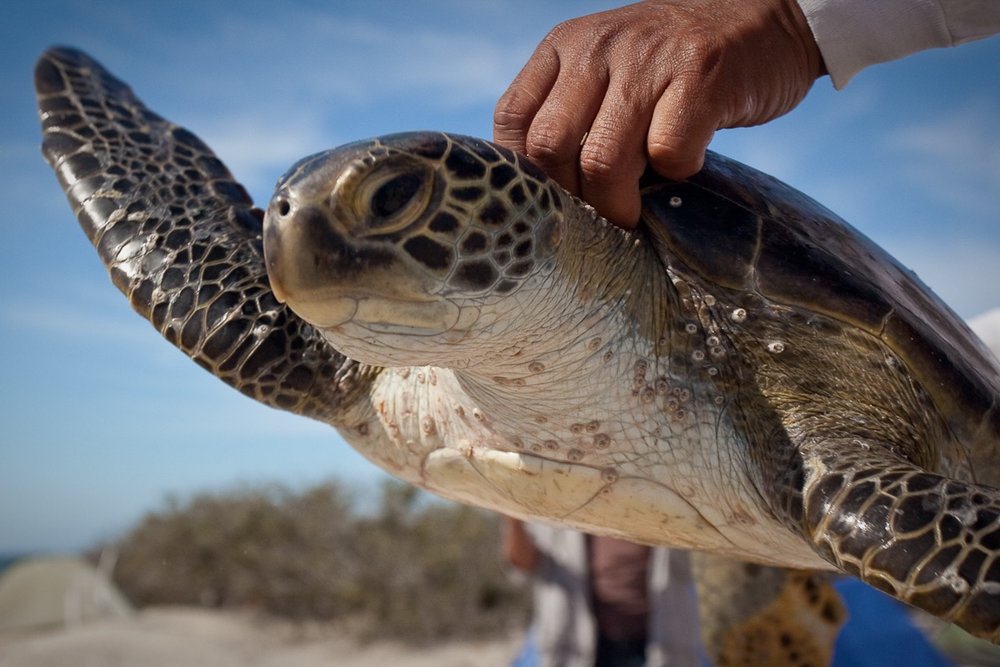Baja Life Magazine: Fishermen Saving Endangered Sea Turtles
- wallacejnichols
- Jan. 9, 2000

by Melissa Paxton, Baja Life Magazine (January 2000)
The tides may be truly be changing along both coasts of the Baja Peninsula for the five endangered species of sea turtle who claim Baja’s waters as home. Against all odds, many of the fishermen once known to hunt these turtles are now turning out in large numbers to insure their survival. From Punta Abreojos, on the Pacific coast of the peninsula, to Cabo Pulmo, a small town on in the East Cape at Baja’s southern tip, fishing communities are joining the sea turtle recovery effort.
Coastal people have consumed sea turtles by the thousands in northwestern Mexico and every year their populations have declined, despite strict laws protecting them in Mexico and the U.S. Turtle meat plays a key role in the local culture and remains a traditional dish in Baja California.
Recently, intensified sea turtle protection efforts are providing an opportunity for eco-tourists to offer “hands-on” support. Similar to the highly popular whale watching tours operated by local fishing cooperatives along Baja’s vast coastline, visitors are now able to join fishermen and researchers for a day of sea turtle watch, nesting beach patrols and sometimes even tagging and tracking projects.
Dr. Wallace J. Nichols, Director of the Wild Coast conservation team and a sea turtle researcher, explains that “we must place a value on these animals aside from their value as food. Fishermen are realizing that sea turtles are worth more to them alive than as a one-time soup feast. It’s a similar process that has occurred with the gray whales.”
Imagine the thrill of riding along in a fast moving panga, miles off the Pacific coast, searching the horizon with binoculars for a rare, loggerhead turtle with a tern perched on its back. Or picture the joy of coming upon a raft of giant kelp, moving along in the current, with a juvenile Pacific green turtle on board, resting in the sun. Walk the beaches with volunteers through the night searching for nests of the highly endangered leatherback turtle.
Since 1997, the effort to promote participation of the Baja fishing communities in the Baja sea turtle conservation has been led by Nichols and his Mexican and U.S. colleagues. The team formed a group now known as the Sea Turtle Conservation Network of the Californias (Grupo Tortuguero de las Californias). “Members of the group live and work from northern California to southern Baja. The region represented includes a wide range of sea turtle habitat,”notes Nichols.
Nichols’ collaborators include co-researcher Jeffrey Seminoff and Antonio and Bety Resendiz—biologists working in the Sea of Cortez’s Bahía de Los Angeles, Fernando Arcas—the Director of Grupo Ecologista de Antares, A.C., an environmental conservation organization in Loreto and the School for field Studies—a marine studies research facility based in Puerto San Carlos on the shore of Bahía Magdalena. The team has determined that turtles from as far away as Japan and Hawaii come to feed and grow in Baja’s waters. They have tracked loggerhead and green turtles from Baja to their natal beaches in Japan and Michoacan. Nichols points out, “We’ve learned a lot about sea turtle biology, but now we need to put what we know into action to save these animals. Although we know a lot more than we used to, turtle populations keep declining.”
The team knows that the key to saving sea turtles is collaboration with the fishermen who daily decide the fate of hundreds of turtles and have always been at the core of the team’s research efforts.
While every member of the Grupo Tortuguero is valuable, certain key fishermen deserve special recognition for their dedication to the fledgling group’s cause. Rodrigo Rangel and Adan Hernandez of Puerto San Carlos have spent the past three summers working with Nichols in Bahía Magdalena and along the Pacific coast as research assistants. Isidro Arce has also played an important enforcement role protecting turtles in the Punta Abreojos region. Thanks to a grant in honor of the late Bob Snodgrass, Isidro Arce attended the International Sea Turtle Symposium in Orlando, Florida in March 2000. Following the conference, Arce returned home to Punta Abreojos and worked with his fishing cooperative with increased determination to create a turtle safe sanctuary in the waters north of Laguna San Ignacio.
The work of these men should not be underestimated. Sometimes they have discussed sea turtle conservation with friends and family members in the midst of a turtle feast! Each is now working as a regional coordinator for the Grupo Tortuguero, which continues to grow.
This previous January 2000, the second annual Grupo Tortuguero de Baja California conference was held in Loreto, with over 150 people in attendance. Representatives from six major fishing communities: Punta Abreojos, Puerto San Carlos, Cabo San Lucas, Cabo Pulmo, Bahía de Los Angeles and Juncalito took part in the two day event. The meeting, composed of an assortment of people interested in the recovery of Baja California’s sea turtle populations, focused a strong emphasis on fishing community involvement in turtle protection.
This year the meeting will again be held in Loreto, B.C.S., Mexico on January 26-28, 2001. The group expects an even bigger turnout. To attend the meeting or to support the efforts of the Grupo Tortuguero, contact Wild Coast at wildcoast@mail.com or visit the Web site www.wildcoast.net
If you have information about sea turtles, please feel free to email the group.
You Can Help the Turtles
To volunteer for a sea turtle research project or take courses for college credit, contact one of these organizations: